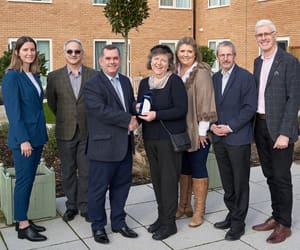An Interview with Sean Kime: Care Home Design & More

It must have been a proud moment when newly opened Falkland Grange recently won the Best Specialist Dementia Design category at the prestigious Pinders Healthcare Design Awards. Did it come as a surprise?
Yes, although I’m not sure it should have been a surprise, as an enormous amount of work, research, thought and care goes into the design process. I am very grateful to the judges for recognising this, and will continue to strive for the best design possible for the residents in our care.
Porthaven is growing a strong reputation for thoughtful design throughout. Where do you start when you are drawing up plans for a new home? What type of people do you employ at the concept stage? What level of research is done?
The shape and size of the site dictates the shape of the building, its location within the site and number of floors. We then work out where to place the key access areas such as the car park, main entrance and service entrance, and then bedrooms and dayrooms to make the most of any views from the building. Service areas are located to be easily accessible by staff but as discrete as possible from residents and their visitors.
We have worked with Condy Lofthouse Architects for many years. They are a key part of the Porthaven design team, and are the first to be involved, even before we acquire a new site. Every care home building is unique in its shape and size, but we follow the same design ethos from the beginning: the function of the building should provide a suitable environment for residents and for our staff to be easily able to care for them. Everything in the design must flow from that, and I am not afraid of scrapping an initial set of plans or layouts if they do not meet this primary design brief. I frequently review and refine the floor plans from when they are submitted for planning right up until our chosen contractor is on site, trying to ensure the layout is as ergonomic as possible. I visualise every single room, and make many subtle tweaks to room layouts as we proceed, so every space works to its intended purpose. I enjoy this process hugely.
Next, I work with Care Home Interiors, another key member of our design team, to design every aspect of the interiors, from the carpets, to paint, to door handles, to furniture, curtains and signage. These elements are crucial in creating the right environment and ‘feel’.
Gardens have always been very important to us at Porthaven, and a few years ago we began working with Deacon Design Landscape Architects to create different areas within the outdoor space for residents to enjoy.
I have always looked outside the care home sector for design ideas and inspiration from country hotels, to private residences, or any buildings with some design or feature that might add a creative or practical element to our care homes. When it comes to dementia design, we have always looked to the Dementia Services Development Centre (“DSDC”) at Stirling University for guidance and ideas to add to our own experience of caring for residents living with dementia. A couple of years ago I also arranged a two-day design course for the design team with DSDC to ensure we all have up-to-date learning. Much of this was already incorporated within our care homes, but it’s always good to remember the impact that dementia plays in older people’s lives, and what we can do to make their lives easier and less confusing. One of the most useful research tools I also use is simple observation. Watching our residents within our homes also helps me to understand the things that work, the things that aid them in living, and making them as independent as possible.
There was quite a list of elements considered in the competition, including resident comfort, indoor and outdoor accessibility, signage, design features, staff needs and aesthetic features. Can you talk in a little more detail about how these play to Porthaven’s strengths?
I am a ‘details’ person, believing that every element of a design should be considered, not only for how it works on its own, but also how it interacts with everything else in the space. This fusion creates a cohesive and thoughtful space, where no one element jars or stands out. Comfort and safety is the primary goal but it is also important to make it easier for our staff to take care of our residents, so that excellent care can be delivered.
It must be a difficult balance to combine functionality with creating a home for residents that is both attractive and comfortable, particularly for residents if their needs become greater during their stay. Can you give examples of how practicality is incorporated into each individual care home, particularly for those with dementia?
It is not a simple task to design a space that works practically for people living with dementia, while also making it stylish or homely. We try to make the practical elements as discrete as possible. For example, people living with dementia can lose the ability to see colour, so contrast becomes important to be able to separate different elements. The upholstered furniture therefore should not contain too much pattern in the area that the resident needs to focus on to sit down. We use a plain fabric for the seat cushion, arms and backrest, and then we pipe it in a contrasting colour to delineate the edges of the different parts. That enables anyone with restricted eyesight to pick out what they need to see to be able to hold on and sit down safely. We then utilise a little more pattern on the back of the chair and the pillows, and tie that in to curtains and other decorative elements of the décor. The armchair looks stylish but is also practical for the residents.
Another recent innovation involved the fire extinguishers, which were mounted on the walls near the nurse stations for easy access. We are obviously obliged to have extinguishers but previously, some residents living with dementia would walk around the care unit collecting different items, one of them being the fire extinguishers, and take them to their bedrooms. The care staff retrieved them continually, and eventually ended up keeping them in a locked cupboard, which was not helpful in the event they were needed in an emergency. I proposed we create a discrete cabinet in the side of the nurse stations to house the fire extinguishers, fronted with neat glass doors that are kept closed with magnetic catches. The residents now no longer focus on the extinguishers or take them away, and the staff know where the extinguishers are kept at all times.
Dementia can be a challenging and distressing condition. How do you prepare your staff to best help their residents and how does the design of the building help with that?
Our staff are our greatest asset, carrying out their different roles with the residents’ best interests at heart. Incoming staff are selected for their empathy and focus in care, and then supported with training in how to care for residents living with dementia.
The dementia floor is specifically designed so that residents are cared for in smaller groups. There is a living room and dining room in one room and adjacent to a section of bedrooms, so smaller groups of residents can live together in a cluster. There are three of these clusters on the dementia floor and we group residents together in a cluster with others that have similar needs. It is easier for the staff to know how to approach and care for a group of residents. It also helps when it comes to mealtimes as the staff can be in the dining area preparing the tables and the food, and still be able to watch and communicate with the residents in the sitting area. It is then a simple matter for the residents to move the short distance to the tables when they are ready to eat.
In conclusion, what do you consider sets Porthaven apart from other care homes?
We started Porthaven with the specific intention of designing and building care homes that are fit for the purpose of modern care. That might sound obvious, but the care sector is awash with homes that are either conversions of buildings that were built for another purpose, or older style purpose-built buildings that no longer meet the needs of current residents.
We set out to ensure that the homes we build work as a practical but stylish place to live, as well as making it easier for the staff to carry out their duties. We want residents to feel at home and happy in our care home environment, and for staff to enjoy the important work they undertake to care for those residents.
